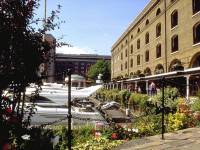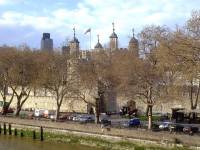

Tower Hamlets was created in 1963 from the amalgamation of the Metropolitain boroughs of Stepney, Poplar and Bethnal Green, and therefore comprises most of what is commonly known as London's East End.
It has always been a working-class area, a tradition that is only very recently starting to change following the recent Docklands and riverside redevelopments. Its original 16th-century inhabitants were craftsmen, labourers and others who supported the businesses and activities of the wealthier City dwellers. Almost inevitably it grew into an industrial area, a role given a particular impetus as London's status as a port began to mushroom. Here in the East End were facilities for unloading goods, for storing them and for processing them. It was always been a poor area, its inhabitants often living and working in wretched conditions. It was probably at its worst in the time of Charles Dickens, whose novels revealed to the population at large a world of deprivation and urban squalour.
The area suffered badly during the second world war, taking the worst of the Blitz. The wartime devastation was followed by the decline of the docks, the area's major industry; ocean-going cargo ships were getting steadily bigger and could no longer enter the dock basins. Although much of the indigenous population dispersed, the London County Council embarked on a post-war rebuilding scheme and the area became largely residential instead of industrial. Much of the borough consists of a mix of post-war housing estates and the remains of the Victorian and Edwardian terraces and workshops; it is either utilitarian or plain ugly and little of it has any attraction to the visitor.
There are two major exceptions, however, and the picture galleries will concentrate on these. By an administrative accident, it seems, a prime piece of London's history lies within the borough; the Tower of London, dating from 1067, is situated at its southwestern extremity. The Tower has been an integral part of Royal London and has served as a fortress, a residential palace, a barracks and a prison. Nowadays it is primarily a tourist attraction and is most famous for housing the Crown Jewels. Adjacent is the relatively modern Tower Bridge; only a century old, it was nevertheless built in a flamboyant Gothic style to match the Tower and is now one of the major icons of London.
The other exception is the most far-reaching. London's docks, in their heyday, sprawled over eight and a half square miles; the greater proportion of this area was in Tower Hamlets. The closure of the docks prompted a massive urban regeneration scheme, the scale of which dwarfed the earlier LCC housing renewal plan. Almost a third of the borough was razed and rebuilt from scratch - and, to a very high standard. The centrepiece of the new Docklands development is at Canary Wharf, on the site of the old West India Docks on the Isle of Dogs, but this is just one of a dozen bold new plans that have transformed this area of London for ever. The slums have gone, replaced by shining new office buildings, imaginative and attractive housing developments, public open spaces and the inevitable service and leisure infrastructure. Tower Hamlets is, for the first time, firmly on the itinerary of the tourist and the visitor.
 |
Docklands |
 |
St Katharine's Dock |
 |
Wapping |
 |
Tower of London and Tower Bridge |
 |
Spitalfields Market |
Back to London Cityscapes index
This page last updated 15th June 2006
![]()
1209